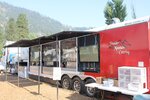
As the wildfire season continues to stretch across forests, the entire country remains captive. Newsstands bear a dizzying variety of headlines with words like 'containment', 'destroy', and 'evacuation', snagging attention from worried citizens. Staggering numbers regarding wind percentage, acreage and temperatures stack up to illustrate the danger of the fires. People pile into community meetings, dumbfounded by the wildfires happening in their own backyard. Collectively, there is a wide-eyed fascination and fear for the fires but above that there is also unanimous awe for the firefighters on the front lines. Those individuals taking on the fire headfirst make the idea of a hero three dimensional. From a behind the scenes lens, this is where the firefighters retreat after a 15 hour day and the mechanics behind keeping them going.
"40,388 acres with about 907 personnel on the fire as of this morning (Friday, August, 24)," said Michael Reichling, fire marshal. "This fire camp was established because we have to manage all the resources coming in to fight the fire. Fire camp is where all of the magic happens when it comes to managing all the resources out here, it's a very militarized system."
Pulling up on the dirt road entrance to the fire camp located at the Leavenworth National Fish Hatchery, there's a gaggle of men that swoop in to double check identification. The fire camp is an invite only affair and the strict procedure to enter only marinates the importance of what is being conducted on the grounds.
There are endless rows of tents lined up where the firefighters retire to catch brief spurts of sleep before hustling back to the front lines. Gesturing around the camp, Reichling directed his attention toward the large boards that were scattered throughout the grounds, serving as a targeted destination for those inquiring updates. Scanning the board, there's an array of flyers and a map with recent information. There are forest service updates both in English and Spanish, the fire map and the activity situation report for the entire United States all stapled to the board.
"We have information boards around the camp we keep updated cause we internally have to keep people updated as well as externally," said Reichling.
Some of the internal subsections of the general staff are sectioned off into individual tan tents where beneath the entrance flaps are a series of constant activity. There's operations who run the crews and Reichling referred to as working 'boots on the ground'. Their neighbors are the planning group who take care of mapping and looking at the next operational period to gauge what resources are needed based on current condition of the fire. Along the row, there is logistics those in charge of the mechanics of what keeps the machine churning ahead: food, water, showers, medication are in the realm of their responsibility. Another tan tent is the finance part of the operation, similar to a banker's nine to five or a part time shift at the local deli, the staff on the camp ground also fills out time sheets and finance takes care of pay. And looking above the row of tents, there's a cable that travels to a trailer to provide the camp's own Internet system.
"It is a very well oiled machine when it comes to supplying everything we need to do to get the fire contained," said Reichling. "That's the bottom line. That's why we're here."
Glancing around the grounds, there's a variety of state license plates and even another country's flag waving beneath our own stars and stripes. Reichling pointed out the Australian flag and explained that help for the fires went beyond the U.S. border.
"We have Australians out here working and New Zealanders. They came over, I think there's 50 or so. They came in, did a transition type of training and then they're out on the different fires," Reichling said.
Many of the force behind the fire camp are individuals that were dispersed across the country and funneled into the Fish Hatchery located fire camp to help out.
"You meet these people from all over the country, it's just amazing," said Reichling. "It's a constant supply, resupply situation here. I've been doing this for forty years and it still amazes me how it all comes together."
Notably there's many Idaho adorned vehicles due to the contracted catering company traveling across state lines from Boise, Idaho to provide three meals a day. There is hot breakfast and hot dinner provided and a sack lunch. For lunch, even those that tend to be herbivores can vouch for the vegetarian option whereas others snag the regular brown bag before hurrying back to their individual duty. There's a sign with large letters reminding those in line for food to wash their hands or splash some Purell on their palms.
"Sanitation is one of the major concerns out here," said Reichling. "When you get a thousand people living in a field one sickness can really spread far from food, human touch."
So while it can be tempting for do-gooders to show their gratitude with a basket full of sweet treats for the firefighters, that risks contamination and possibly causing a widespread sickness to infiltrate the camp. Instead of showing thanks in the form of Nana's homemade chocolate chip cookies, Reichling says put up signs with encouraging sentiments for the firefighters: "THANK YOU". A simple enough gesture, but one that is just as sweet as sending baked goods.
Regardless of how big or small the poster is, how scribbled or neat the handwriting is - just putting up a sign boosts morale and illuminates the gratefulness for the individuals that curl up in a tent after long hours, are limited to two cloths for a brief shower and have to face the fire that keeps us all on edge.
Comments
No comments on this item Please log in to comment by clicking here